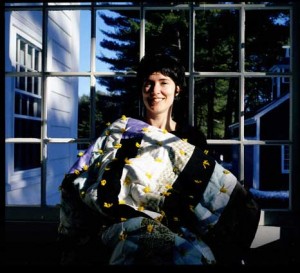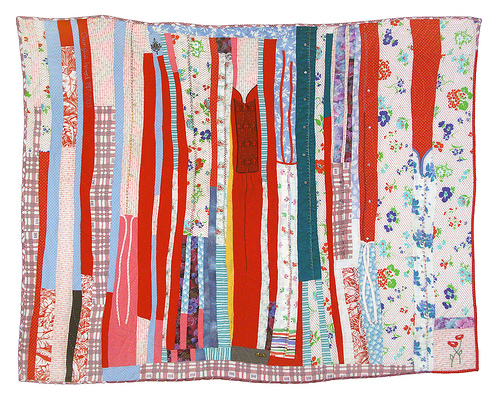I first discovered the craft of passage quilting just a few months ago when I featured artist Sherri Lynn Wood here at SevenPonds, and I was very excited to invite her to chat with us more in-depth about the process.

Dana: How does passage quilting help guide people through the bereavement process?
Sherri: Quiltmaking has historically been a part of women’s storytelling and women’s expression. People have always made quilts as memorials to lost loved ones, whether they have thought of the process or not.
The process is really about relationships, and there are parallels in the process of making the quilt to the bereavement process. Creating the quilt creates a safe container for people to stay grounded while they process their grief. They can focus on learning real skills –sewing, putting together the materials, learning the craft – to couch and to reflect the internal process:
1. Gather the materials. This is an opportunity for people to share memories and tell stories as they choose the clothing that has the most memories and the most meaning attached to it. They have to be thoughtful of choosing clothing that is the most descriptive of the person. A lot of people find comfort in sharing that process with me, as the facilitator. A lot of people will tell me the story of how the person died, and share memories of the person with me, and that sharing is really important to a lot of people.
2. Tearing or cutting clothes apart. This can be really intense for some people, and sometimes they don’t even want to be a part of this step; sometimes they want to do it on their own. This is the point where people have to acknowledge that the person is really gone, that they will no longer be around to wear these clothes.
3. Piece the quilts together. I use an improvisational process, which is pretty unique. I discourage people from trying to create a pattern have a preconceived notion of what they want to create. Instead, I encourage them to work with the architecture of the clothing itself, which is important in two ways:
First, preserving the architecture of the clothing preserves the essence of the body of the person who wore it – their height, or shape, or the design of their favorite dress, for example.
Second, it’s very much like the grieving process, in which the regular patterns of your life have been disrupted. As you go through the grieving process, your patterns have to be recreated, and you don’t know how they will evolve. With improvisational quilting, it’s very much the same. People don’t know how the quilt will evolve. They have to trust the process. And people always see the beauty of what they have created in the end.
The process of piecing together the quilt really touches on relationships. As people are connecting the materials, they are thinking artistically about creating relationships with the patterns and fabrics, but they are also creating relationships between the memories attached to those clothes. By going through this process, they are transforming the relationship with the person.
4. Quilting, piecing together the 3 layers that make up the actual quilt. Until now the process was just creating the top layer. In any situation, quilting is very meditative. You’re in the same posture you are in in mediation or prayer: bent head, heart centered between your head and your hands, your hands moving rhythmically. The process is very slow; it takes a long time, and it allows the person to meditate on their memories.
Quilting also allows a person to choose when they will face those memories. They can say “I’ll allow myself to be involved in the memories and set the time that I want to do it.” Then they can put it away when they want and pull it back out when they want. It’s important for the person to know that the quilt is still there and they can pull it out anytime and interact with those memories.
5. Having the object itself. Finally, at the end of the process, people have the quilt which can be a great comfort. The object holds memories and stories, and they can bring it out and wrap up in it anytime.
Having the object can also be a vehicle for storytelling. Particularly with difficult deaths, it can encourage people to feel comfortable talking about the issues that are awkward to bring up. Having the quilt helps surpass the facts surrounding the death, because it is about who the person was, not about how they died.

Next week, Part 2: Sherri tells me about how her artwork evolved into a social practice, and how she found healing through quiltmaking.
Read Part Two of the interview with Sherri Lynn Wood.

 An Interview with Sherri Lynn Wood
An Interview with Sherri Lynn Wood


 First the Wealth Gap, Now the U.S. Has a Growing Health Gap
First the Wealth Gap, Now the U.S. Has a Growing Health Gap

 Our Annual Seven Holiday Gifts for Someone Who Is Grieving, 2024 Edition
Our Annual Seven Holiday Gifts for Someone Who Is Grieving, 2024 Edition














